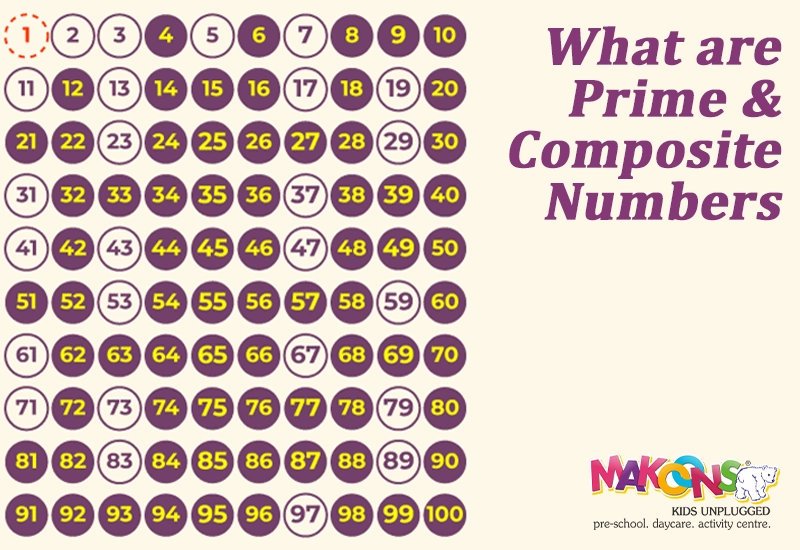Hey there, young math explorers! Are you ready to learn about some cool numbers? Today is an adventure to find children’s prime and composite numbers. Not to worry; it will be easy and enjoyable!
What Are Numbers Really Like?
Consider numbers as several kinds of toys available in your play box. Some toys are simple and don’t come apart – these are like prime numbers. Other toys have lots of pieces that fit together – these are like composite numbers!
What Are Prime Numbers?
Just like the unique “loner” numbers in arithmetic, prime numbers stand out as special. They’re very special because they only have exactly two friends who can divide them evenly. These two friends are always the number 1 and the number itself.
Only two numbers – 1 and themselves may equally divide a prime number; prime numbers are defined as such. No other numbers can divide it without leaving some leftover pieces.
Why Is 2 So Special?
Here’s a fun secret: Believe it or not, two is the sole even prime number. Due to divisibility by 2, non-prime even numbers possess a greater number of factors. 2 holds the primary position among prime numbers.
What Are Composite Numbers?
Composite numbers are the friendly, social numbers. They love having lots of friends and can be divided evenly by many different numbers.
What are composite numbers? These are numbers that have more than two friends who can divide them evenly. Numbers that are divisible by at least three different numbers.
Teaching Prime Numbers to Kids: Fun Games
Learning math should feel like playing! Engage with prime and composite numbers through these fun practice methods:
The Friendship Test Game
Let’s play a number game! Choose any number you like. Now, ask this: “How many whole numbers divide my chosen number without leaving a remainder?” Let’s check the divisors! Only two? The number is PRIME! More than two? Hooray, it’s COMPOSITE!
Number Detective Mystery
See yourself as a code-breaker cracking numerical challenges. You have to review every number falling between 10 and 30. Provide the complete factorization of each given number. The numbers with only two friends are the prime suspects!
Color-Coding Adventure
Get some crayons and create a number chart covering 1 to 50. Distinguish prime from composite numbers by assigning a unique color to each category. Select one shade to color all primes and a different hue for all composites. Watch the beautiful pattern that appears!
The Building Block Challenge
Consider composite numbers as flexible LEGO blocks with several configurations. Twelve blocks can be set up, for instance, as three rows of four blocks or two rows of six blocks. Prime numbers are like special blocks that can’t be arranged in different rectangular shapes!
The Special Number 1
An interesting note is that neither prime nor composite is the number 1. It’s like the unusual student in the class that doesn’t fit into any one group. The sole buddy of number 1 is itself! So it gets to be in its special category.
Math Guide for Kids: Easy Tips to Remember
Here are some super helpful tricks to make learning prime and composite numbers stick in your brain:
The Two-Friend Rule
Remember: Prime numbers are shy and only have exactly two friends. Composite numbers are popular and have three or more factors!
The Even Number Trick
Except for the number 2, all even numbers are composite. Why? Even numbers are special because they can all be split into two equal groups, meaning each number has a bonus companion!
Use Your Fingers
Count the friends (factors) of each number on your fingers. Two fingers up means prime, three or more fingers means composite!
Real-World Prime and Composite Magic
Did you know that prime and composite numbers are everywhere around us? Bees use mathematical patterns in their honeycombs, and computer games use these special numbers to create codes and puzzles!
Even when you arrange chairs for a party, you’re using these concepts. You can only build one row from your seven seats, as seven is prime. But if you have 12 chairs, you can arrange them in many different ways (because 12 is composite)!
Helpful Hints for Parents and Teachers
Teaching prime numbers to kids works best when you:
- Use hands-on activities and visual aids
- Connect math to things kids already know and love
- Celebrate every correct answer, no matter how small
- Make it a game rather than work
- Instead of cramming, practice a little every day.
Your Math Adventure Continues
Understanding prime and composite numbers is like learning a secret code to solve more challenging arithmetic riddles. Every mathematician began exactly where you are right now—interested and eager to grow!
This arithmetic guide for children marks only the beginning of your numerical journey. Prime and composite numbers will assist in your understanding of fractions, common denominators, and solving many kinds of interesting mathematical problems.
Remember that every math pro was once a novice just like you; keep practicing, be curious, and never forget. Having pleasure while learning is quite crucial!
Also Read – What are Composite Numbers? Definition, Meaning, List, Examples
Ready, Set, Math!
Now, young people hold the hidden meanings of prime and composite numbers! You know what composite numbers are—the gregarious ones with lots of friends—and prime numbers—the shy ones with just two buddies.
Get some paper, choose some numbers, and get right to your investigating. Soon you will be a prime and composite number master, ready to wow your friends and relatives with your amazing arithmetic prowess!
Recall: Math is all around us; one step at a time, you are transforming into a number superhero!

